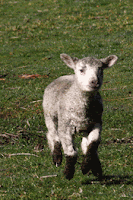Who doesn’t want to attract fairies to their garden? Of all
the herbs associated with the little folk, the most important one is thyme,
which I love. I’m forever planting more varieties of thyme. In Shakespeare’s A
Midsummer Night’s Dream, Titania, the fairy queen, sleeps in a bed
of wild thyme growing on a bank. Sure. Why not?
(Thyme in our garden)
Foxglove is also essential for a fairy garden. According to legend, fairies sleep in the bell-shaped flowers, and wear them as gloves. Which use they choose, probably depends upon the size of the fairy. Other common names for foxglove include fairy fingers, fairy thimbles, and fairy cap. However, I'm extremely challenged in growing foxglove in my farm garden(s). The plants soon figure out they're not in their native dappled woodlands.
Another favorite herb
is saffron, also known as the saffron crocus, which bloom in the
fall. Fairies are said to be especially fond of this culinary herb/spice used
for flavoring cakes and dyeing cloth. Other recommended plants are fragrant
rosemary and roses. Roses are much loved by fairies for their beauty and divine
scent, and by me. And I am never without rosemary. I bring these essential herbs
indoors in pots in late fall. They’re not exuberant about life in my
sunspace but generally survive to glory again in summer. Wood anemones are
beautiful plants preferred by fairies because the flowers close at the onset of
bad weather and at night and offer the tiny beings a safe spot to rest or wait
out the bad weather. I have some anemones, also called windflowers. These beauties grace the spring garden.
(Rosemary, Geraniums, and Lavender in my garden)
Not
to neglect bluebells, also beloved by fairies. These beautiful blue flowers
that carpet woodlands in spring are also known as harebell,
Scottish bellflower, and fairies thimble. It was, and maybe
still is, widely believed that fairies live among the flowers. Another name for
bluebells is Dead Man's bells because fairies were thought to cast spells
on those foolish enough to pick or damage the delicate blossoms.
When
meandering through drifts of bluebells, it’s wise to stick to the path, or you
may stir up the wrath of fairies and release the spells trapped in the blooms.
Never a good idea, and one that would be echoed by our resident fairy expert,
my 12-year-old niece, Cailin, who warns never step into a circle of flowers or
go anywhere without the fairies' permission, or they will get very upset. And
you do not want an upset fairy, or fairies, on your hands. Particularly the
furious wind fairies, but that’s another story.
(Virginia bluebells and narcissus in my garden)
A
dear author friend of mine who is quite knowledgeable about fairies says they
love many kinds of herbs and flowers. She has spotted some tiny ones in
photographs of my garden. I’ve read they are drawn to the same plants that
attract butterflies and hummingbirds. Keep watch, you never know where they may
be.
If you're interested in learning more about herbs and herbal lore, you may enjoy my book, Plants For A Medieval Herb Garden in the British Isles, available in print and kindle with lovely images at: https://www.amazon.com/Plants-Medieval-Garden-British-Isles/dp/1496111494
Blurb: An illustrated collection of plants that could have been grown in a Medieval Herb or Physic Garden in the British Isles. The major focus of this work is England and Scotland, but also touches on Ireland and Wales. Information is given as to the historic medicinal uses of these plants and the rich lore surrounding them. Journey back to the days when herbs figured into every facet of life, offering relief from the ills of this realm and protection from evil in all its guises.
For more on me visit my blog: https://bethtrissel.wordpress.com/






























